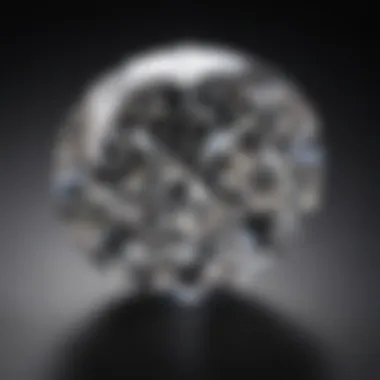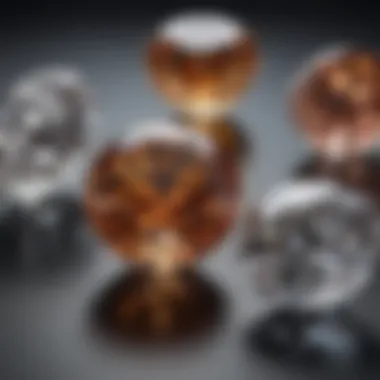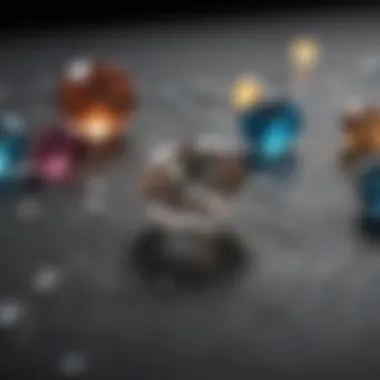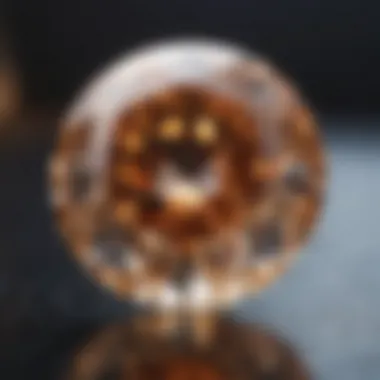Understanding the Value of a One-Karat Diamond


Intro
The diamond, often hailed as the enduring symbol of love and status, embodies more than just brilliance and beauty. Specifically, the one-carat diamond occupies a significant niche in both the gemstone market and the hearts of consumers. Understanding its value demands an exploration beyond surface-level aesthetics. Various factors contribute to its pricing and desirability.
In this piece, we will unravel the nuances surrounding one-carat diamonds. From the Four Cs—cut, clarity, color, and carat weight—to market trends that dictate demand, each element plays a role in defining worth. Additionally, insights into certification will provide context, ensuring informed choices for both buyers and investors.
Let’s delve into the gemstone’s characteristics to lay the foundation for a deeper understanding of its value.
Intro to Diamond Value
Understanding the significance of diamond value is essential for anyone involved in buying, selling, or appreciating diamonds. One-carat diamonds, in particular, capture the attention of both consumers and investors alike. Their size is often considered a benchmark, making them a focal point in discussions about worth and number of considerations. The value of a diamond goes beyond its mere presence. Factors such as quality, rarity, and market demand play a crucial role in determining how much a one-carat diamond may cost.
This section will delve into the core elements essential for comprehending diamond value, offering insights that are beneficial to gemstone enthusiasts, collectors, jewelry designers, and geology enthusiasts.
Defining Diamond Value
The concept of diamond value may seem straightforward at first glance. However, it is nuanced and layered. When defining diamond value, it is important to note that it encompasses several dimensions. Intrinsically, it relates to the physical characteristics of the diamond, like its size, quality, and overall appearance. Market value, on the other hand, pertains to prevailing economic conditions and consumer trends. This duality contributes to a comprehensive understanding of how diamonds, particularly one-carat diamonds, are valued.
Some key components that affect intrinsic value include:
- Quality: This refers to the Four Cs – cut, color, clarity, and carat weight. Each of these factors contributes to the overall perception of the diamond's quality.
- Rarity: Not all one-carat diamonds are created equal. Certain shapes and characteristics can be more sought after, driving up value.
- Market Demand: The demand for diamonds fluctuates based on trends and consumer preferences, affecting pricing.
The intricate balance between intrinsic and market value makes understanding diamond pricing a sophisticated endeavor.
Importance of One-Carat Diamonds
One-carat diamonds hold a notable position in the diamond market. Their size is often perceived as ideal for engagement rings and other types of jewelry. This perception enhances their desirability among consumers. The importance of one-carat diamonds lies not just in their aesthetics but also in their investment potential. They are a standard that many buyers consider when stepping into the diamond market.
From an investment perspective, one-carat diamonds often serve as a stable and recognizable asset. Their size typically signifies a balance between affordability and luxury. Generally, buyers are likely to find a vast range of options in this category, catering to different budgets and preferences. Several factors elevate their significance:
- Versatility: One-carat diamonds can fit various styles, making them appealing for different types of jewelry.
- Resale Value: Many one-carat diamonds maintain a reasonable resale value, providing security for those making a purchase.
- Cultural Recognition: They are often associated with significant life events, enhancing their emotional value.
Understanding these elements allows potential buyers to make informed choices and helps assess the true value of one-carat diamonds in today’s market.
The Four Cs of Diamonds
When considering the value of a one-carat diamond, it is essential to understand the Four Cs: Cut, Color, Clarity, and Carat Weight. These criteria are the cornerstone of diamond evaluation, influencing not just aesthetic appeal but also market value. Each "C" holds specific importance in determining how a diamond is perceived and priced.
The Four Cs collectively guide consumers in making informed decisions about their purchases. They serve as a language through which the quality and rarity of diamonds are articulated, enabling buyers to compare options effectively and aligning their choices with personal preferences or investment strategies.
Cut
The cut of a diamond refers to how well it has been shaped and faceted. This aspect greatly determines the diamond's brilliance, fire, and light performance. A high-quality cut can elevate even a lower-clarity or poorer color diamond, while a poorly cut diamond can diminish overall visual appeal, regardless of its superior qualities in other Cs.
In practical terms, the cut grade ranges from Excellent to Poor, considering factors like proportions, symmetry, and polish. An ideal cut diamond reflects light beautifully, creating a stunning sparkle that captivates attention. It is advisable to prioritize cut quality when choosing a diamond, as this trait notably influences the overall appearance and value.
Here are some key points about diamond cuts:
- Shape: Includes popular options like round, princess, or oval cuts.
- Proportions: Impact the diamond's light return and brilliance.
- Cut Quality: Defined by the skill involved in crafting the diamond.
Color


Color is evaluated on a scale, with D being colorless and Z representing light yellow or brown tones. The value of a diamond inversely correlates with color; meaning, the less color present, the higher the value. A colorless diamond (D) is the most sought after, while those with visible hues will typically fetch lower prices.
However, some can appreciate a subtle hue, often favoring fancy colored diamonds for their unique appeal and distinctiveness. These can vary widely in terms of rarity and pricing. When assessing color, consider:
- Hue: The actual color seen, which affects desirability.
- Intensity: How saturated or strong the color appears.
- Distribution: How evenly the color is showcased throughout the diamond.
Clarity
Clarity accounts for the presence of inclusions or blemishes within a diamond. The fewer imperfections a diamond has, the higher its clarity grade. Clarity grading ranges from Flawless to Included, each indicating the visibility of internal or external flaws.
Clarity markedly influences a diamond's value and appeal. A high-clarity diamond can significantly enhance the overall perception of quality. Some buyers prioritize clarity, while others may deem this feature less important depending on the stone’s cut or color combination.
Important considerations regarding clarity include:
- Type of Imperfection: Inclusions can be crystals, feathers, or chips.
- Location: Where the imperfection is located can affect brilliance.
- Visibility: Under magnification or with the naked eye.
Carat Weight
Carat weight measures the size of a diamond, and one carat is equivalent to 200 milligrams. Larger diamonds are rarer and thus carry higher prices per carat.
Interestingly, a one-carat diamond may not be twice the price of a half-carat diamond, as the pricing often follows a non-linear scale influenced by demand, rarity, and market conditions. For many buyers, the perception of size versus quality is crucial. In essence, knowing the relationship between carat weight and overall value can help refine choices.
When discussing carat weight, contemplate:
- Size Perception: Different cuts can appear larger or smaller for the same carat weight.
- Pricing: Larger diamonds significantly increase in price per carat due to rarity.
- Personal Preference: Size may be more important than other C's for some buyers.
Understanding the Four Cs is foundational for anyone interested in one-carat diamonds. They not only create a framework for assessing value but also help buyers align with their individual preferences and investment goals. Knowing the nuances of cut, color, clarity, and carat weight allows a discerning buyer to choose wisely.
Market Factors Influencing Diamond Value
Understanding the market factors is crucial for anyone interested in the value of diamonds, particularly one-carat stones. Various influences shape the pricing dynamics in this industry. The interactions between supply and demand, economic conditions, and cultural trends determine how diamonds are viewed in the marketplace. Each of these elements contributes to the overall value perception and can help both buyers and sellers make informed decisions.
Supply and Demand
The principle of supply and demand is a fundamental aspect of the diamond market. When the supply of one-carat diamonds is lower than the demand, prices tend to rise. Conversely, if there is an oversupply, prices may decrease. Several factors can lead to these fluctuations. Natural disasters, mining regulations, and market competition can all impact the availability of diamonds. Additionally, consumer trends can shift demand. For example, a sudden surge in interest for a specific cut or color can lead to increased demand for that particular style, affecting prices significantly.
Economic Conditions
Economic conditions influence consumer behavior and thus, the diamond market. In times of economic prosperity, luxury items such as diamonds may see a rise in sales and prices. Consumers often feel more confident spending on high-value items when they have job security and disposable income. On the flip side, during economic downturns, people tend to prioritize essential needs over luxury purchases. This reduction in demand can lead to lower diamond prices. Additionally, interest rates and inflation can also play a role, affecting how buyers perceive the value of their investments in diamonds.
Cultural Trends
Cultural trends significantly shape how diamonds are purchased and valued. Over the years, the symbolism of diamonds has evolved. For instance, engagement rings featuring one-carat diamonds are often seen as a standard, elevating the stone's desirability. Social media platforms like Facebook and Reddit influence popular perceptions about diamonds, particularly among younger consumers. Jewelry designs and preferences shift as cultural tastes change, impacting demand in the market. Furthermore, ethical considerations around diamond sourcing are becoming increasingly significant to consumers. More people are looking for conflict-free diamonds and are willing to pay a premium for traceable, ethically sourced stones.
"The interplay between supply and demand, economy, and culture is essential in determining the true value of a one-carat diamond."
By grasping these market factors, potential buyers and sellers can navigate the complexities of the diamond industry better. Recognizing how these influences operate not only facilitates better purchasing decisions but also enhances investment strategies.
Assessment and Certification


Assessment and certification play a crucial role when it comes to the evaluation of one-carat diamonds. These processes serve to establish the quality, authenticity, and overall value of a diamond, enhancing buyer confidence and ensuring transparency in transactions. When a diamond undergoes certification, it is appraised based on several critical factors such as color, clarity, cut, and carat weight. This thorough evaluation is indispensable for both buyers and sellers.
Role of Gemological Laboratories
Gemological laboratories are specialized institutions that focus on evaluating diamonds and other gemstones. They employ experts who use advanced technology and methods to determine a diamond's characteristics in a detailed and standardized way. The importance of these laboratories cannot be overstated for several reasons:
- Expert Assessment: Trained gemologists have the knowledge required to accurately evaluate diamonds, minimizing the risk of misrepresentation.
- Standardized Grading Systems: Laboratories follow consistent grading criteria, making it easier for buyers to assess diamonds objectively.
- Credible Reports: Certification from a recognized gemological laboratory enhances a diamond's value and trustworthiness. Some well-known laboratories include the Gemological Institute of America (GIA) and the American Gem Society (AGS).
This certification explains the reasons buyers feel more secure making purchases when diamonds are accompanied by professional evaluation reports, leading to informed decision-making.
Understanding Diamond Grading Reports
A diamond grading report is a detailed record that outlines the characteristics of a diamond as assessed by a gemological laboratory. Understanding this report is crucial for anyone looking to invest in diamonds. The report typically includes the following elements:
- Cut: This section explains the quality of the diamond's cut, which impacts its brilliance.
- Color: The report indicates the color grade, affecting overall appearance.
- Clarity: This assesses any inclusions or blemishes present.
- Carat Weight: The total weight of the diamond is clearly stated.
- Additional Information: Many reports include a plotted diagram of the diamond, highlighting its unique features.
Having access to a grading report allows buyers to make more informed decisions. It helps to verify if the stated quality matches the price being charged.
"A credible diamond grading report is essential for ensuring that a buyer receives exactly what they pay for in terms of quality and characteristics."
Buying and Selling One-Carat Diamonds
Understanding the dynamics of buying and selling one-carat diamonds is essential for collectors and enthusiasts alike. The value of these diamonds is influenced by numerous factors, such as market demand, quality, and purchasing avenues. Making informed decisions can lead to significant benefits, whether one is looking to acquire a diamond for personal use or as an investment.
Retail vs. Wholesale
When purchasing a diamond, individuals often face the choice between retail and wholesale. Retail prices are generally higher, reflecting the overhead costs that jewelers incur. These include rent, marketing, and maintenance of inventory. Retailers pride themselves on providing customer service and tailored experiences, potentially including services such as diamond setting, resizing, or bespoke design.
On the other hand, wholesale offers a different approach. Wholesalers typically sell diamonds in bulk to retailers, making their prices lower. This can provide savings for buyers willing to engage directly with wholesalers. However, buying from wholesale suppliers often requires knowledge about the diamond market, including how to assess quality and understand certification.
For those seeking an investment, the wholesale market can offer more competitive pricing, allowing for potential profit margins when reselling in the future. It is essential, however, to assess the risks associated with buying larger quantities and ensure that proper certification is in place.
Online vs. In-Store Purchases
The avenue for purchasing a one-carat diamond has broadened with the rise of online retailers. Shopping online can provide convenience and access to a broader range of selections. Many online platforms feature comprehensive filters for the Four Cs, making it easier to compare diamonds based on personal preferences. This increases transparency in pricing, allowing buyers to find competitive deals.
Nevertheless, in-store purchases come with unique advantages. Being able to see and touch the diamond before buying can provide essential insights that images and descriptions cannot convey. In-person shopping allows potential buyers to engage directly with knowledgeable sales staff, offering the chance to ask questions and receive personalized recommendations.
Ultimately, a buyer’s choice between online and in-store purchasing will depend on their comfort level with each method. Knowing what matters most—be it pricing, service, or selection—can inform this decision. Online shopping might be more budget-friendly, while visiting a physical store may enhance the buying experience.
"Choosing the right avenue for diamond purchase can impact both the financial outcome and personal satisfaction of the buyer."
Investment Considerations
The investment considerations surrounding one-carat diamonds are multifaceted and crucial for potential buyers. As the market for gemstones evolves, understanding the financial aspects remains essential for making informed decisions. Diamonds can serve as both a sentimental purchase and a potential asset capable of appreciating over time. Therefore, buyers must carefully weigh their options and consider a range of factors when investing in one-carat diamonds.
Long-Term Value Appreciation


Investing in a one-carat diamond could present a long-term value appreciation opportunity. Unlike many other luxury goods, diamonds have displayed a tendency to retain value. However, this is not universally true for all diamonds. Factors such as quality, origin, and market trends play significant roles in determining worth.
Buyers should focus on gemstones with desirable features. For instance, a high-quality one-carat diamond graded for excellent cut, clarity, and color can yield better long-term value compared to lesser options. Investors may find it prudent to seek diamonds that are GIA-certified. These certifications provide an objective assessment of the diamond's characteristics, thereby securing its place in the market.
While historical data shows that high-quality diamonds can appreciate over time, there can also be fluctuations in value. It is important to note that such historical appreciation rates vary based on market conditions and buyer demand. Building a diverse collection, with attention to various types and qualities of diamonds, may mitigate risk and enhance potential returns.
Market Volatility In Diamonds
Investment in diamonds is not without risk. The market can be unpredictable and volatile, influenced by a variety of factors. These include changes in consumer preferences, economic conditions, and industry dynamics.
For example, during economic downturns, luxury goods, including diamonds, may see reduced demand. Conversely, during prosperous times, demand may surge, thereby inflating prices. Understanding the cyclical nature of the diamond market is crucial for investors.
To navigate market volatility effectively, consider:
- Timing Your Purchase: Buying during periods of lower demand can lead to better deals.
- Research Market Trends: Keeping informed about economic indicators and consumer behavior can help in making timely investment decisions.
- Diversification: Owning a range of gemstones can reduce overall risk when one category underperforms.
Ultimately, comprehending these investment considerations for one-carat diamonds can arm buyers with the necessary insights for informed decision-making, fostering long-term satisfaction and potential profit.
Care and Maintenance of Diamonds
Caring for your diamond is crucial for preserving its brilliance and value over time. A one-carat diamond, whether set in an engagement ring or worn as a pendant, requires specific attention to maintain its appearance and integrity. Knowledge of appropriate care practices can ensure that your diamond continues to radiate its beauty for years to come.
Cleaning Techniques
Regular cleaning is essential to keep a diamond sparkling. Dirt, oils, and other substances can accumulate on both the diamond and its setting, diminishing its shine.
- Basic Cleaning: A simple solution of warm water and mild dish soap can do wonders. Soak the diamond for about 20 to 30 minutes, then gently scrub it with a soft toothbrush. Rinse thoroughly under warm water.
- Ultrasonic Cleaners: These machines can efficiently clean diamonds by using high-frequency sound waves. However, be cautious with older settings or diamonds with inclusions.
- Professional Cleaning: Many jewelers offer professional cleaning services. This is valuable especially if the diamond exhibits significant dullness or signs of wear.
“Regular maintenance can significantly extend the life of your diamond jewelry.”
Preventive Care
Preventive care minimizes the need for extensive cleaning and helps protect your diamond from potential damage.
- Avoid Harsh Chemicals: Household cleaners can be too abrasive. It’s best to remove diamond jewelry before using cleaning products.
- Routine Inspections: Have your diamond inspected by a jeweler at least once a year. They can check for loose settings or other issues that may arise over time.
- Proper Storage: Store diamonds in a soft cloth or separate compartments in a jewelry box to prevent scratches. This is especially important for one-carat diamonds, as even small blemishes can affect their market value.
Caring properly for diamonds enhances their visual appeal and preserves their emotional and financial significance. By implementing effective cleaning techniques and maintaining preventive measures, one can ensure their diamond remains radiant and valuable.
Culmination
In this article, we have delved into the intricate world of one-carat diamonds. The culmination of our exploration highlights the multifaceted nature of diamond value. Understanding what contributes to this value is vital for anyone interested in diamonds, whether for personal acquisition or as an investment.
Importance of the Ending
The conclusion serves as a synthesis of the preceding sections, linking the factors discussed regarding diamond valuation. By examining the Four Cs — cut, color, clarity, and carat weight — one can better appreciate why certain diamonds command higher prices. Additionally, we have discussed external market influences, which include supply and demand dynamics, the impact of economic conditions, and prevailing cultural trends.
For potential buyers, it is essential to grasp these fundamentals. Not only do they prepare you for informed purchasing decisions, but they also equip you with the knowledge necessary to navigate the complexities of the diamond market effectively. Furthermore, knowing how to care for and maintain a one-carat diamond enhances its longevity, thus preserving its value over time.
"A diamond is forever, but its worth can change with the market."
Final Thoughts on One-Carat Diamonds
One-carat diamonds hold a unique position in the jewelry industry. They blend beauty with considerable market value. When buying such diamonds, individual preferences play a significant role. Factors like personal taste, occasion, and budget must be kept in mind. Moreover, viewing diamonds not just as ornaments but as investments can lead to a deeper appreciation of their worth.
In summary, the journey through understanding the value of one-carat diamonds is not merely about their physical characteristics. It is also about the emotional and financial implications they carry. Whether for adornment or investment, knowing the nuances of one-carat diamonds will undoubtedly lead to more satisfying and informed choices.







